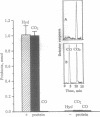Abstract
An unusual mechanism for hydrocarbon biosynthesis is proposed from work examining the formation of (Z)-9-tricosene (Z9-23:Hy), the major sex pheromone component of the female housefly, Musca domestica. Incubation of (Z)-15-[1-14C]- and (Z)-15-[15,16-3H2]tetracosenoic acid (24:1 fatty acid) with microsomes from houseflies gave equal amounts of [3H]Z9-23:Hy and 14CO2. The formation of CO2 and not CO, as reported for hydrocarbon formation in plants, animals, and microorganisms [Dennis, M. & Kolattukudy, P. E. (1992) Proc. Natl. Acad. Sci. USA 89, 5306-5310], was verified by trapping agents and by radio-GLC analysis. Incubation of (Z)-15-[15,16-3H2]tetracosenoyl-CoA with microsomal preparations in the presence of NADPH and O2 gave almost equal amounts of (Z)-15-3H2]tetrasosenal (24:1 aldehyde) and Z9-23:Hy. Addition of increasing amounts of hydroxylamine (aldehyde trapping agent) caused a decrease in hydrocarbon formation with a concomitant increase in oxime (aldehyde derivative) formation. The 24:1 aldehyde was efficiently converted to (Z)-9-tricosene only in the presence of both NADPH and O2. Bubbling carbon monoxide (20:80 CO/O2) or including an antibody against housefly cytochrome P450 reductase inhibited the formation Z9-23:Hy from 24:1 aldehyde. These data demonstrate an unusual mechanism for hydrocarbon formation in insects in which the acyl-CoA is reduced to the corresponding aldehyde and then carbon-1 is removed as CO2. The requirement for NADPH and O2 and the inhibition by CO and the antibody to cytochrome P450 reductase strongly implicate the participation of a cytochrome P450 in this reaction.
Full text
PDF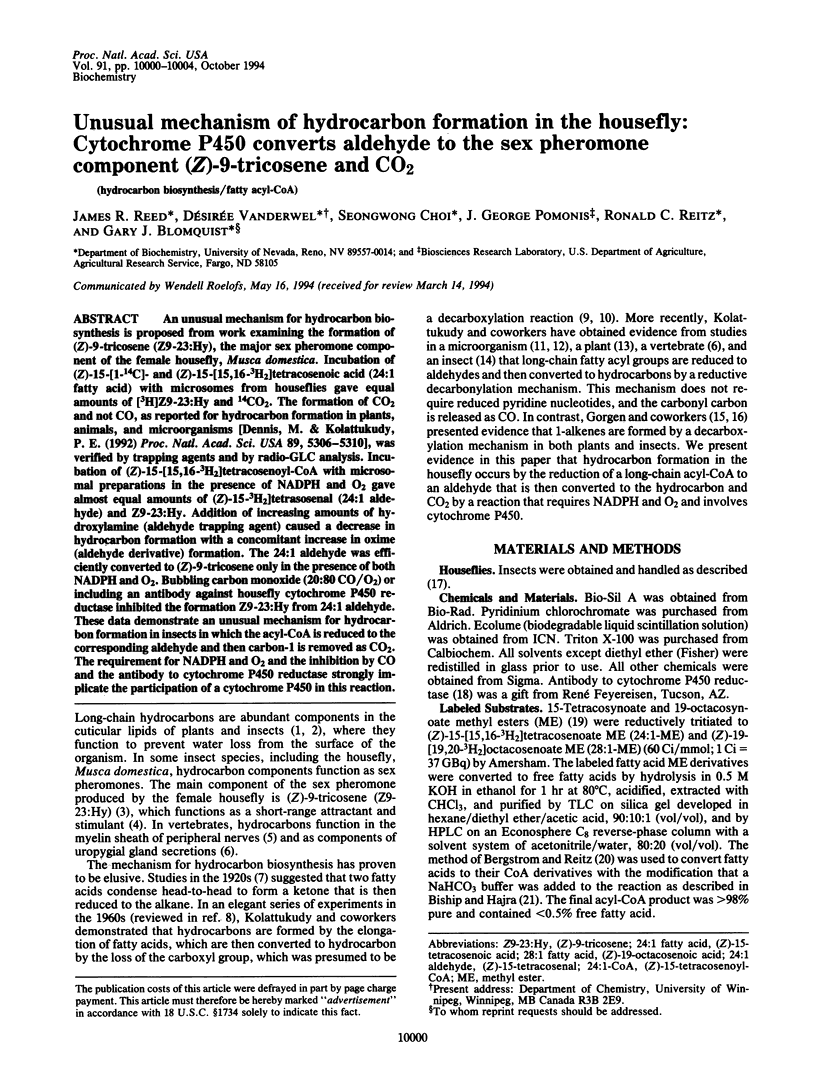

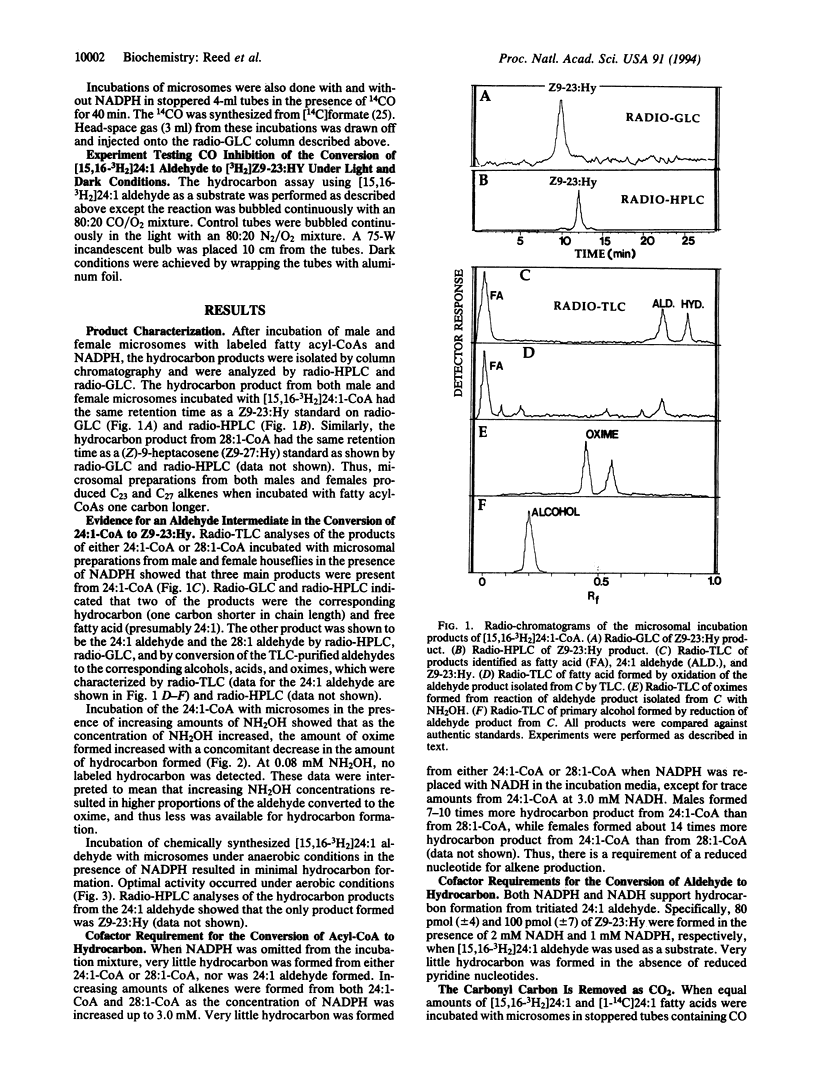
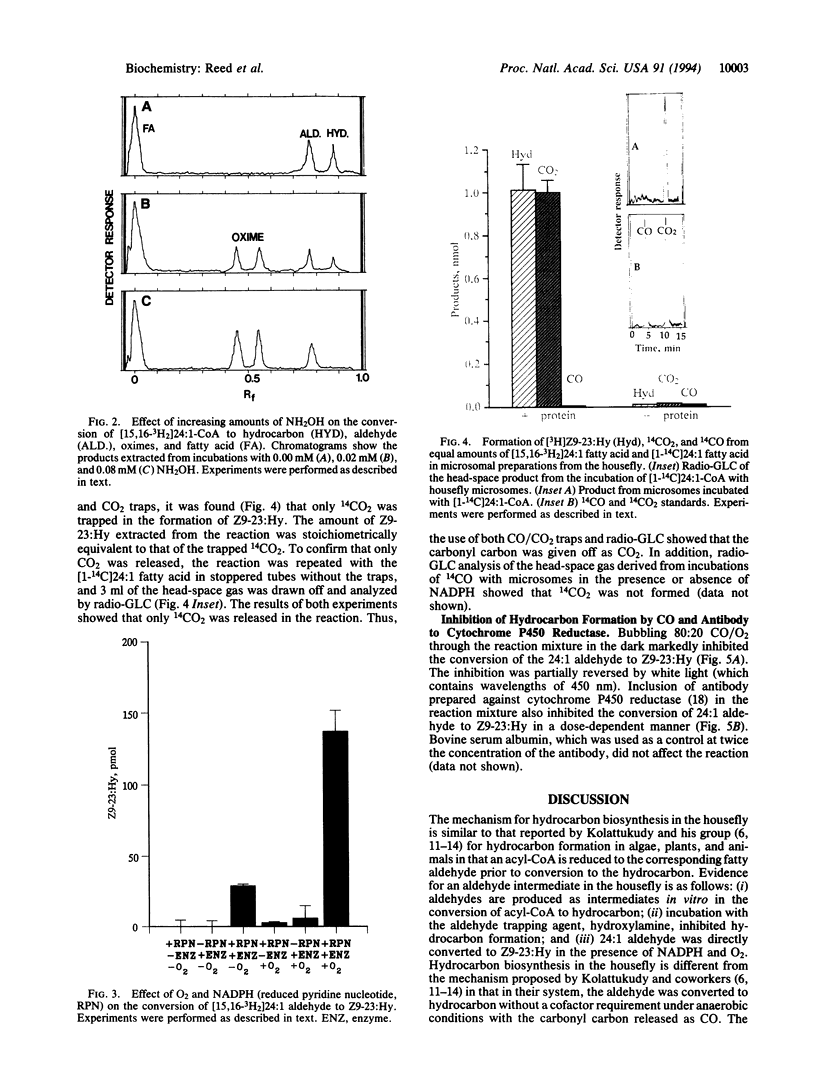
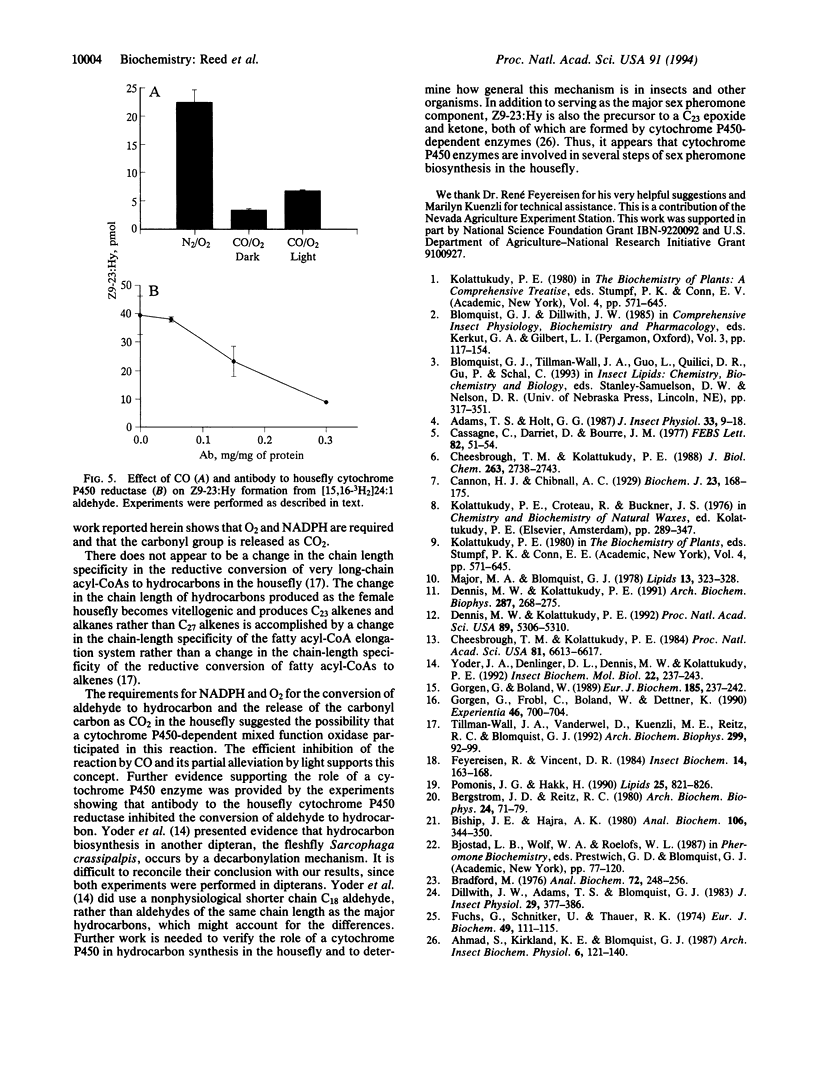
Images in this article
Selected References
These references are in PubMed. This may not be the complete list of references from this article.
- Bergstrom J. D., Reitz R. C. Studies on carnitine palmitoyl transferase: the similar nature of CPTi (inner form) and CPTo (outer form). Arch Biochem Biophys. 1980 Oct 1;204(1):71–79. doi: 10.1016/0003-9861(80)90008-9. [DOI] [PubMed] [Google Scholar]
- Bishop J. E., Hajra A. K. A method for the chemical synthesis of 14C-labeled fatty acyl coenzyme A's of high specific activity. Anal Biochem. 1980 Aug;106(2):344–350. doi: 10.1016/0003-2697(80)90531-x. [DOI] [PubMed] [Google Scholar]
- Bradford M. M. A rapid and sensitive method for the quantitation of microgram quantities of protein utilizing the principle of protein-dye binding. Anal Biochem. 1976 May 7;72:248–254. doi: 10.1016/0003-2697(76)90527-3. [DOI] [PubMed] [Google Scholar]
- Cassagne C., Darriet D., Bourre J. M. Evidence of alkane synthesis by the sciatic nerve of the rabbit. FEBS Lett. 1977 Oct 1;82(1):51–54. doi: 10.1016/0014-5793(77)80883-1. [DOI] [PubMed] [Google Scholar]
- Channon H. J., Chibnall A. C. The ether-soluble substances of cabbage leaf cytoplasm: The isolation of n-nonacosane and di-n-tetradecyl ketone. Biochem J. 1929;23(2):168–175. doi: 10.1042/bj0230168. [DOI] [PMC free article] [PubMed] [Google Scholar]
- Cheesbrough T. M., Kolattukudy P. E. Alkane biosynthesis by decarbonylation of aldehydes catalyzed by a particulate preparation from Pisum sativum. Proc Natl Acad Sci U S A. 1984 Nov;81(21):6613–6617. doi: 10.1073/pnas.81.21.6613. [DOI] [PMC free article] [PubMed] [Google Scholar]
- Cheesbrough T. M., Kolattukudy P. E. Microsomal preparation from an animal tissue catalyzes release of carbon monoxide from a fatty aldehyde to generate an alkane. J Biol Chem. 1988 Feb 25;263(6):2738–2743. [PubMed] [Google Scholar]
- Dennis M. W., Kolattukudy P. E. Alkane biosynthesis by decarbonylation of aldehyde catalyzed by a microsomal preparation from Botryococcus braunii. Arch Biochem Biophys. 1991 Jun;287(2):268–275. doi: 10.1016/0003-9861(91)90478-2. [DOI] [PubMed] [Google Scholar]
- Dennis M., Kolattukudy P. E. A cobalt-porphyrin enzyme converts a fatty aldehyde to a hydrocarbon and CO. Proc Natl Acad Sci U S A. 1992 Jun 15;89(12):5306–5310. doi: 10.1073/pnas.89.12.5306. [DOI] [PMC free article] [PubMed] [Google Scholar]
- Fuchs G., Schnitker U., Thauer R. K. Carbon monoxide oxidation by growing cultures of Clostridium pasteurianum. Eur J Biochem. 1974 Nov 1;49(1):111–115. doi: 10.1111/j.1432-1033.1974.tb03816.x. [DOI] [PubMed] [Google Scholar]
- Görgen G., Boland W. Biosynthesis of 1-alkenes in higher plants: stereochemical implications. A model study with Carthamus tinctorius (Asteraceae). Eur J Biochem. 1989 Nov 6;185(2):237–242. doi: 10.1111/j.1432-1033.1989.tb15108.x. [DOI] [PubMed] [Google Scholar]
- Pomonis J. G., Hakk H. Synthesis of omega 9-tetracosynoic and omega 9-octacosynoic acids as entries into tritiated metabolic precursors of cis-9-tricosene and cis-9-heptacosene in the housefly. Lipids. 1990 Dec;25(12):821–826. [PubMed] [Google Scholar]
- Tillman-Wall J. A., Vanderwel D., Kuenzli M. E., Reitz R. C., Blomquist G. J. Regulation of sex pheromone biosynthesis in the housefly, Musca domestica: relative contribution of the elongation and reductive steps. Arch Biochem Biophys. 1992 Nov 15;299(1):92–99. doi: 10.1016/0003-9861(92)90248-u. [DOI] [PubMed] [Google Scholar]



